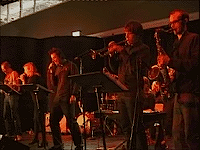Many art processes conceptually
bundle their own systems of production and phenomenology into their execution.
From Robert Morris's 1961 Box With the Sound of its Own Making to all manner of viral media interventionism, visual arts have explored the
contexts that surround their own production, circulation, and reception, and
have often exploited these systems to great effect. Some artworks reside in the
performed actions of artists and/or audiences alike, from Bruce Nauman's 1974
instructional text Body Pressure to the inter-subjective encounters of 1990s relational art.
In music, mediation of a score by trained performers is the norm rather than the exception, whether it be a harpsichordist's embellishment of a Bach basso continuo, a pianist's nuanced tempo rubato in the performance of Romantic miniature, a jazz musician's improvised solos over a notated chord progression, or a performer's interpretation of Earle Brown's open-form score for December 1952.
Recent composers have extended the exploration of human engagement to involve people outside of a conventional stage ensemble. This section turns the spotlight on works that take audience or other human engagement as a significant aspect of shaping a project. The unpredictability of human interaction can become its own chaotic system, adding real caprice to the capriccio of a composition.



